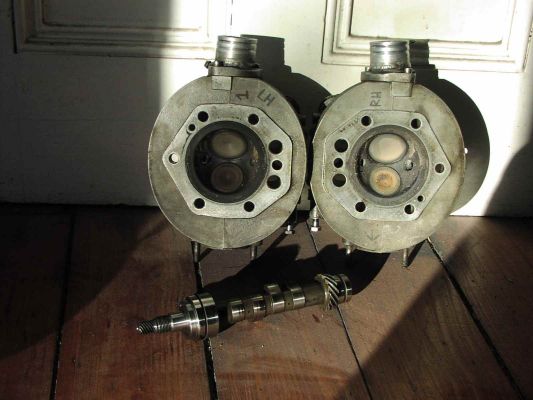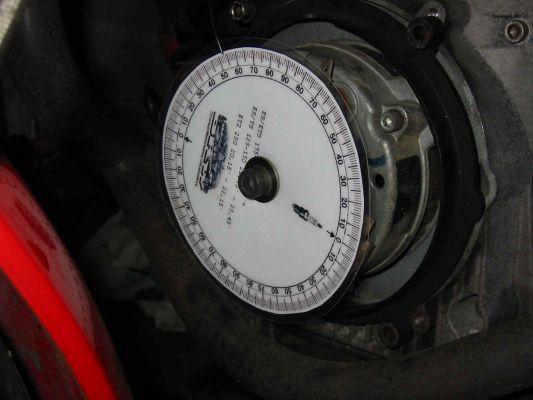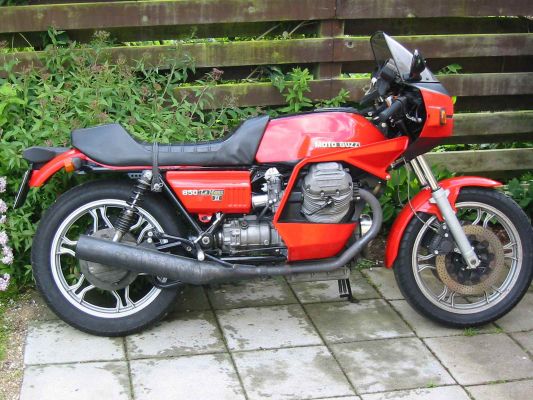Site: Danish | English
6: Not much light on an old Guzzi.
8: The first year is over.
Technical : The complex stuff - exciting but heavy reading, take your time.
Please contact Gregory Bender with any questions, corrections, or suggestions for improvement.
Mikael's Story
8: The first year is over.
I drove more than 7000 km in 2003 before we reached late November and it got too cold to stay fun for riding. The last trip is always special. You know that spring is a long way away. Considering the fact that my winter project 2002 should have been two new handle grips (which by the way still havent been changed), things escalated a bit, as you have read. Was it the wrong bike I bought; should I have sold it to someone else when I realised that it wasnt in prime condition? Yes, a lot of you might think. Personally I was rather pleased and had become rather fond of it. I had a run on a Yamaha 600 – a 4 cylinder thing – belonging to a colleague. It hit me how “refined” it was compared to mine. You are reminded of a Toyota Corolla. It works – but it wasnt exciting in my opinion. Swap it? Not in my lifetime. I dont think he was ready to, either – thank God that people are different.
One of the fun things about a large V2 is the way it pulls. Step on it and it takes off. If you need speed – when you overtake for instance – shift a gear down and it pulls even harder. Not like my colleagues Yamaha where you need to take it down 2 or 3 gears to get enough revolutions to make it move for real. What if you could make it pull even harder – wouldnt that be even more fun? Quite a few people think so. To ride “fast” isnt important to me – I tried that when I was young. And I dont need to prove myself to anyone when it comes to speed.
If you need more power, you need to know what you want. More punch all over would be nice, but a performance camshaft would typically move the action to the higher revolution area. A Guzzi is great since it has so much torque and pull heavily in the middle area. The only (easy) way to get more torque is to get a bigger engine. A 1000 cc engine has a bigger torque than a 125, but not necessarily more horsepower. A bigger engine is straight forward. As mentioned earlier you can get bigger cylinders/pistons to bolt on. 950 cc – which Guzzi calls 1000 – can be installed without any modifications what so ever. If you want more than 1000 cc it needs machining of the cylinder (???) block but that is to go a bit too far in my opinion. I might change my mind on a later date – you never know.
Another thing which is characteristic to an old Guzzi is its extremely heavy flywheel compared to other motorbikes. A heavy flywheel is not necessarily bad but all old Guzzis, right from the Le Mans to the Californias, have the same heavy flywheel. A heavy flywheel has the advantage that it ensures a steady running of the engine, but it takes time and energy to spin it up. A very popular modification on sport Guzzis is to change this – that is to lighten the flywheel.
When it comes to camshafts there are various types – right from the lawn mower cam that my bike was born with to extreme models completely unsuited for street use. Bigger carburettors, modification of the exhaust system or the cylinder heads are other ways to go when you hunt more power. It is also very popular to make a dual-plug – that is to modify the cylinder heads so each contains two plugs.
To tell the truth, I now basically had a fairly well running motorbike – but an entire winter with nothing to do. After thinking about it for quite a while, and consulting a guy in North Zealand, who is the guy to talk to for advice on things you dont know how to do – or dont want to do yourself - the following was decided:
A 1000 cc kit, a P3 camshaft, and a somewhat lighter flywheel/clutch were needed. Other things that was fixed or modified were the u-joint which was quite worn, and changing of lots of bolts from the original ones that corroded at the first sign of moisture, to new stainless ones. One gasket in the gearbox had a tendency to sweat oil so this was fixed, too. I also had to do something about the front fork, too. First of all it had lots of rusty pitting spots, which irritated me, and secondly it felt a bit under damped when the bike was ridden hard. New forks, gaskets, springs and everything else can be bought as spare parts, but several people suggested that I should get a Marzocci fork. The diameter of its tubes is bigger – and thus more solid. This demanded the bridges to be changed or that the original ones had to be bored from 35 to 38 mm as far as I remember. It wouldnt be much more expensive to put on a new one compared with a renovation, so I made up my mind. I felt like doing everything myself but had to realise that first of all I didnt have room for it and secondly it was a bit out of my league.
Parts were ordered – for instance a RAM clutch with a flywheel. I bought the camshaft used from a guy in Scotland. As you maybe can see from the picture he also had 2 cylinder heads modified for dual-plug for sale. I didnt buy them – but perhaps I will modify mine in a similar way one day. The camshaft cost 120 euro – or a bit less than 1000,- DKK and was in perfect condition. Fair deal both the seller and I thought.
It is a good idea to use PayPal when you buy parts abroad and need to send money. It is a hundred times easier than to have your bank wire the money. And the person you send the money to has them 2 seconds after you push the send button.

2 Cylinder heads and a P3 cam for sale.
The bike was handed in one day in March and a week later it was ready. After the first few kilometres I found it hard to believe that it was actually my bike. It pulled so much better that I constantly believed that I was in a lower gear than I actually was. And it only has 5 gears! Often I have been looking for a 6th since I thought I was in the 4th gear judging from the pull.
But it has also become more sensitive. You have to be more careful about adjusting the ignition and the carburettor settings. And dont believe that the mere fact that the ignition marks are present on the flywheel ensures any kind of presicion in their position.. I have messed about to try to find the exact top points and thus be able to mark the 8 degree point. My brother in law devised yet another gadget with a rod to adjust the screw in the plughole. You mount a degree wheel on the generator and turn the engine slowly until the piston hits the rod. The position on the disc is noted. Then you turn the engine slowly the other way around until the piston once again touches the rod. This position on the disc is noted, too. Exactly in the centre between those two points you have the DTC, Dead Top Center. After that it is easy to find the 8 and the 34 degree mark. I marked the flywheel with correction fluid.
For 200,- DKK you can by an aluminium degree wheel. I didnt feel like it. I found one on the Interned that I printed out and had laminated at work. I can live with the fact that it came with an East German MZ motorcycle ad.

Timing dial.
When it comes to some of the other things I fixed, I will mention that I put on new mirrors – the old ones were no good. I put on a new front tire – the guy I bought it from had changed the back one. A broken bolt at the generator cover has been lured out. The cover itself, which originally was made of ugly black plastic and which had cracked around the 4 bolts that keep it in place, has been changed to a neat new one made in polished aluminium. The velocity stacks, which were made of even uglier grey plastic, have also been changed to some made of polished aluminium. 2 fine new short pins for the rear flashers have been made by my brother in law. The original ones reached almost ½ meter out on each side – a bit too 70ties in my opinion
Furthermore the starter has been changed. Even with a new, fully charged battery it was hardly ably to turn the engine. The old Bosch starter might have been repairable, but in approx. 1992 Guzzi started using another starter made by Valeo. This one is characterized by pulling somewhat stronger and that at a lower power consumption. I searched the Net and found the cheapest dealer in Colorado, USA of all places. Strange, actually, that a French produced starter is sent to the States and then back to Denmark – but the fact is that it works much better than the old one, and that I can recommend it. Furthermore it is easy to bolt on without any modifications what so ever.
What remains to be done? A lot of electrical stuff – relays to mount install. A new windscreen needs to be installed– I have it lying around. The old one is matted, scratched and ugly.
At some stage I probably need to tinker a bit more with the engine – but right now Im quite pleased. The exhaust pipes are originally black. This looks smart but is impossible to keep clean. The front pipes get very hot and even stove paint that handles 8-900 degrees celcius is not enough. The mufflers themselves you can manage to get quite good looking – for a while that is. At some stage something has to be done. A trick I read somewhere – if a painted area of your bike get hit by a stone, nail polish might be the answer. They come in numerous colours and I took a side cover to the nearest drugstore. The young girl in there took great care to find a polish in a matching colour. And for 50,- DKK the result was not bad. If your wife – like mine – says something like “I cant forget that my husband has started using nail polish”, just ignore her.
Will you ever finish? Im not sure – but that is not the question. I enjoy myself working with my bike. And if I ever run out of ideas, I can always buy another old bike and start all over again.
If I have frightened anyone it was never my intention. Just realise that you might be in for quite a lot of fixing if you decide to buy an old bike. If you havent got time or dont feel like doing it yourself it might become expensive. But if you feel like tampering a bit yourself it is not all that difficult. If I can do it – everybody else can. And there is lots of good advices around – all you have to do is ask.
Do I know everything there is to know about Guzzis? No – far from it. For instance I havent tried to optimize carburettors apart from adjusting the mixing screws. I have to try that at a later stage.
Right now I am working on a small problem that has evolved. It works beautifully until reaching working temperature. After that the right cylinder cuts out, but only at low revolutions. If I speed up it works like a dream. A bit annoying stopping at a red light with 2000 revolutions. There must be a bad connection somewhere. But I will find it.
Found it – it turned out to be simple. A choke cable was adjusted too tightly. After having loosened it so that it how has 2-3 mm clearance it is now able to run idle again.

My Guzzi as it looks today.
And by the way – the handle grips have now been changed :-)
